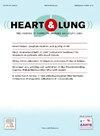心力衰竭患者的抑郁症状和体育锻炼与无事件生存期的关系
IF 2.4
4区 医学
Q2 CARDIAC & CARDIOVASCULAR SYSTEMS
引用次数: 0
摘要
背景心力衰竭(HF)亚型、抑郁症状和缺乏体育锻炼对生存结果有独立影响,但这些变量的相互作用对生存结果的影响仍不清楚。目的我们旨在确定抑郁症状和参与体育锻炼是否有不同程度的相互作用,以预测心力衰竭射血分数降低(HFrEF)或保留(HFpEF)患者的全因死亡或再次住院的综合终点。样本按照有无抑郁症状、是否参加体育锻炼进行分类。结果 共纳入 1002 名心房颤动患者(平均年龄为 64.3 ± 12.7 岁;637 名男性[64%];844 名白人[84%])。其中,35.3%的患者不参加体育锻炼,64.7%的患者参加任何程度的体育锻炼,29.7%的患者有抑郁症状。在这两种亚型中,抑郁症状与全因死亡或再次住院的最高风险相关。结论抑郁症状和缺乏体力活动可预测 HFrEF 患者全因死亡或再住院的综合终点,而抑郁症状本身是 HFpEF 患者的最强预测因素。本文章由计算机程序翻译,如有差异,请以英文原文为准。
Association of depressive symptoms and engagement in physical activity with event-free survival in patients with heart failure
Background
Heart failure (HF) subtype, depressive symptoms, and physical inactivity independently contribute to survival outcomes, but the effect of the interaction of these variables on survival outcomes remains unknown.
Objectives
We aimed to determine whether depressive symptoms and engagement in physical activity differentially interact to predict the combined endpoint of all-cause death or rehospitalization among patients with HF and reduced (HFrEF) or preserved ejection fraction (HFpEF).
Methods
This study was a secondary analysis. The sample was categorized by the presence or absence of depressive symptoms, and engagement or non-engagement in physical activity. Cox proportional hazard modeling was used to predict the combined endpoint of all-cause death or rehospitalization.
Results
A total of 1002 patients with HF were included (mean age 64.3 ± 12.7 years; 637 males [64 %]; 844 White [84 %]). Among them, 35.3 % did not engage in physical activity, while 64.7 % engaged in any level of physical activity, and 29.7 % had depressive symptoms. In both subtypes, depressive symptoms were associated with the highest risk of all-cause death or rehospitalization. Among patients with HFrEF, those with depressive symptoms who did not engage in physical activity were associated with a 136 % higher risk of the combined endpoint, while among those with HFpEF, depressive symptoms and engagement in physical activity were associated with a 78 % higher risk.
Conclusions
Depressive symptoms and lack of physical activity predicted the combined endpoint of all-cause death or rehospitalization among patients with HFrEF, while depressive symptoms alone were the strongest predictor among patients with HFpEF.
求助全文
通过发布文献求助,成功后即可免费获取论文全文。
去求助
来源期刊

Heart & Lung
医学-呼吸系统
CiteScore
4.60
自引率
3.60%
发文量
184
审稿时长
35 days
期刊介绍:
Heart & Lung: The Journal of Cardiopulmonary and Acute Care, the official publication of The American Association of Heart Failure Nurses, presents original, peer-reviewed articles on techniques, advances, investigations, and observations related to the care of patients with acute and critical illness and patients with chronic cardiac or pulmonary disorders.
The Journal''s acute care articles focus on the care of hospitalized patients, including those in the critical and acute care settings. Because most patients who are hospitalized in acute and critical care settings have chronic conditions, we are also interested in the chronically critically ill, the care of patients with chronic cardiopulmonary disorders, their rehabilitation, and disease prevention. The Journal''s heart failure articles focus on all aspects of the care of patients with this condition. Manuscripts that are relevant to populations across the human lifespan are welcome.
 求助内容:
求助内容: 应助结果提醒方式:
应助结果提醒方式:


